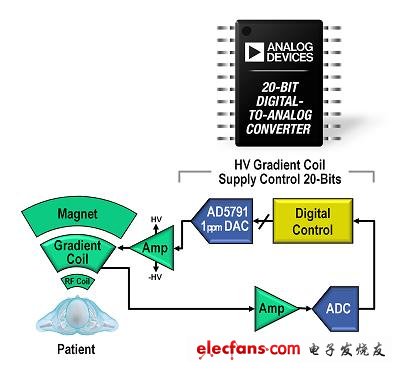There are a variety of imaging methods available today, such as computed tomography, X-ray, ultrasound, and magnetic resonance. Various systems have their advantages and disadvantages. They can be used to generate still images of a certain part or organ of the human body, and can also be used to generate dynamic images for doctors to verify or study the activities of organs. Dynamic images are also used in certain surgeries.
Different systems have different imaging capabilities. X-ray technology is very suitable for the diagnosis of bone diseases. Ultrasound uses sound waves to monitor the fetus and can image the blood flow in organs and atria, ventricles, and blood vessels. MRI is suitable for imaging soft tissues. For the above-mentioned various medical imaging systems, ADI has corresponding professional technical solutions. This article focuses on a new high-resolution DAC developed for high-performance applications such as magnetic resonance imaging (MRI).
Magnetic resonance imaging
MRI is mainly used to produce high-quality images inside the human body, which can be used to detect diseases and distinguish tumors from normal tissues. 70% of the human body is fat and water, both of which contain hydrogen atoms. MRI uses magnetic imaging of hydrogen atoms.
Performing MRI requires a strong homogeneous magnetic field. The unit of magnetic field strength is Tesla (T). 1 Tesla is equal to 10,000 Gauss, and the earth's magnetic field strength is about 0.5 Gauss. Current MRI systems use magnetic field strengths from 1.5 T to 3 T, sometimes reaching 7 T. Such a strong magnetic field is generated by the superconducting coil magnet, and the patient is in the magnetic field. Figure 1 shows the positional relationship between the patient and the MRI scanner coil.

Figure 1. Positional relationship between patient and MRI coil
For 1.5T systems, the applied frequency is approximately 64 MHz, and for 3T systems it is 128 MHz. This will cause proton spins inside the human body to be parallel or anti-parallel to the direction of the magnetic field and thus be in a low or high energy state. The higher the magnetic field strength, the greater the energy difference between the two spin states. After removing the applied magnetic field, the protons forward the magnetic energy, which is measured by the receiving coil or antenna. These antennas are designed with sensitive preamplifiers, gain modules, and high-resolution ADCs, and meet the overall dynamic range requirements of 120 dB to 140 dB. Since we are only interested in imaging small faults of the human body, we need to add a gradient to the homogeneous magnetic field.

Figure 2. High-resolution gradient control loop
A large coil is used to transmit this gradient signal (magnetization vector) in order to provide a response from a single fault of interest. Figure 2 shows the gradient control loop implemented in an MRI system. The signal sent to the gradient coil is generated by an amplifier with an output power of several megawatts. The frequency range is quite low, so the key requirements are stability, high linearity, and low drift. This is exactly what the 20-bit DAC AD5791 has.
The main function of the Solar Energy Storage System is to store the electrical energy generated by the solar panels so that it can continue to supply electricity when the solar panels cannot generate electricity or when the demand for electricity exceeds the supply of the solar panels. It is an energy storage solution for improving the self-sufficiency and energy efficiency of solar power generation systems.
Main effect:
Energy Storage: The Solar Energy Storage System uses batteries to store excess electricity generated by solar panels. When solar panels generate more power than needed, the excess power is stored in batteries to continue supplying power when needed.
Power supply backup: When the solar panels cannot generate enough power, such as at night, in cloudy, or in bad weather, the Solar Energy Storage System can use the stored power to continue to supply power to ensure the continuity and stability of the power supply.
Energy Balance: The Solar Energy Storage System helps to balance the energy difference between the electricity generated by solar panels and the electricity demanded, thus optimizing energy management and maximizing self-sufficiency.
Differences from other energy storage systems:
Power source: The power source of the Solar Energy Storage System is a Solar Panel, which directly generates electricity by converting sunlight. While other energy storage systems may come from other renewable energy sources, such as wind energy, hydro energy, or non-renewable energy sources, such as grid electricity.
Renewability: The Solar Energy Storage System uses solar energy as a power source and is a renewable energy system. Other energy storage systems may utilize different types of energy sources, with varying degrees of renewability.
Application scenarios: Solar Energy Storage System is mainly used in photovoltaic power generation systems, especially in conjunction with solar panels. Other energy storage systems can be used in different energy generation systems, selected according to specific energy sources and application requirements.
Overall, the main function of the Solar Energy Storage System is to store the electrical energy generated by the solar panels for continued power supply at night or when the solar panels are unable to generate electricity. Compared with other energy storage systems, it uses solar energy as a power source, is a renewable energy system, and is mainly used in photovoltaic power generation systems to improve energy utilization efficiency and self-sufficiency.
solar energy storage solutions, solar battery storage solutions, storing electricity from solar panels, power storage for solar panels, 10kw solar system with battery storage
Ningbo Autrends International Trade Co., Ltd. , https://www.aitsolarpanels.com
